Search Result
Results for "
Anti-spasmodic,
" in MedChemExpress (MCE) Product Catalog:
7
Isotope-Labeled Compounds
| Cat. No. |
Product Name |
Target |
Research Areas |
Chemical Structure |
-
- HY-N2604
-
-
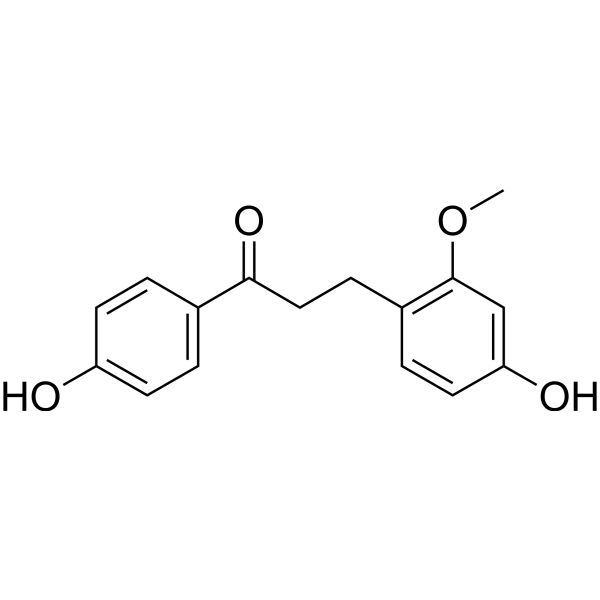
-
- HY-N0820
-
Catalpol
Maximum Cited Publications
6 Publications Verification
Catalpinoside
|
HBV
|
Infection
Neurological Disease
Inflammation/Immunology
Cancer
|
|
Catalpol (Catalpinoside), an iridoid glycoside found in Rehmannia glutinosa. Catalpol has neuroprotective, hypoglycemic, anti-inflammatory, anti-cancer, anti-spasmodic, anti-oxidant effects and anti-HBV effects .
|
-

-
- HY-N5086
-
|
|
HBV
|
Infection
Neurological Disease
Metabolic Disease
Inflammation/Immunology
|
|
Picroside IV is an iridoid glycoside found in the underground parts of Picrorhiza scrophulariiflora. Picroside IV is a derivative of Catalpol (HY-N0820) . Catalpol has neuroprotective, hypoglycemic, anti-inflammatory, anti-cancer, anti-spasmodic, anti-oxidant effects and anti-HBV effects .
|
-
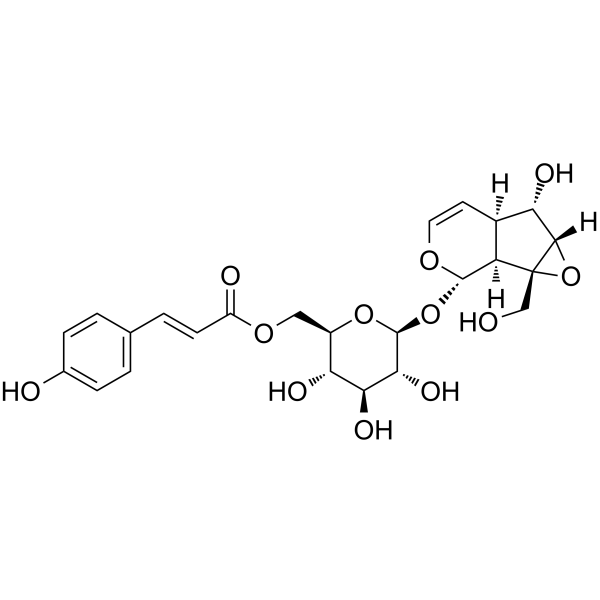
-
- HY-13557
-
Ascomycin
Maximum Cited Publications
6 Publications Verification
Immunomycin; FR-900520; FK520
|
FKBP
Parasite
Fungal
Antibiotic
|
Infection
Neurological Disease
Inflammation/Immunology
|
|
Ascomycin (Immunomycin; FR-900520; FK520) is an ethyl analog of Tacrolimus (FK506) with strong immunosuppressant properties. Ascomycin is also a macrocyclic polyketide antibiotic with multiple biological activities such as anti-malarial, anti-fungal and anti-spasmodic. Ascomycin prevents graft rejection and has potential for varying skin ailments research .
|
-
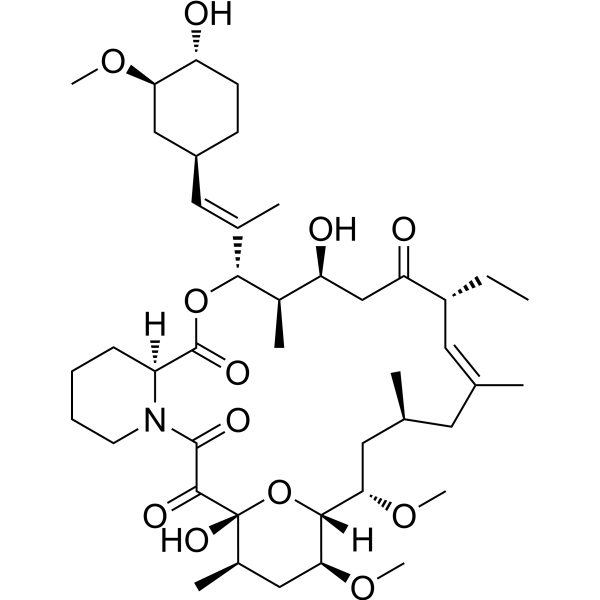
-
- HY-133153S
-
-
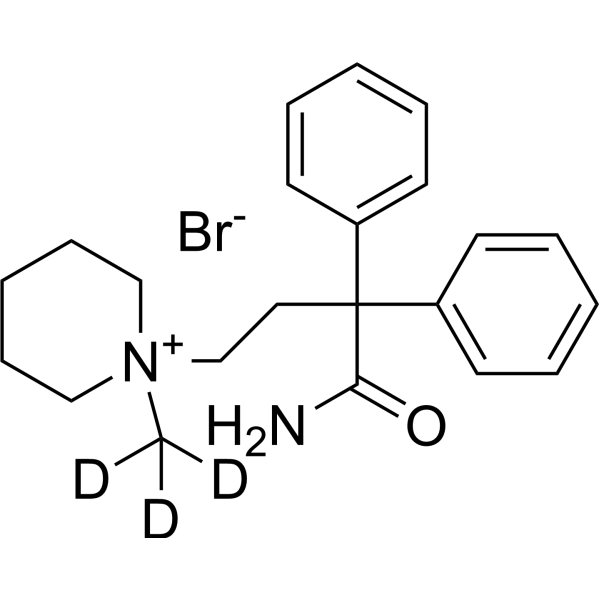
-
- HY-N2071
-
Cedrol
1 Publications Verification
(+)-Cedrol; α-Cedrol
|
Cytochrome P450
Fungal
|
Infection
Inflammation/Immunology
Cancer
|
|
Cedrol is a bioactive sesquiterpene, a potent competitive inhibitor of cytochrome P-450 (CYP) enzymes. Cedrol inhibits CYP2B6-mediated bupropion hydroxylase and CYP3A4-mediated midazolam hydroxylation with Ki of 0.9 μM and 3.4 μM, respectively. Cedrol also has weak inhibitory effect on CYP2C8, CYP2C9, and CYP2C19 enzymes . Cedrol is found in cedar essential oil and poetesses anti-septic, anti-inflammatory, anti-spasmodic, tonic, astringent, diuretic, insecticidal, and anti-fungal activities .
|
-
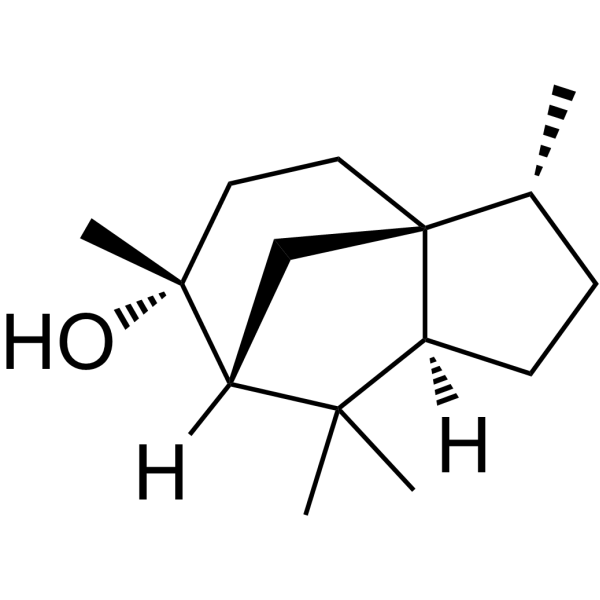
-
- HY-B0326
-
-
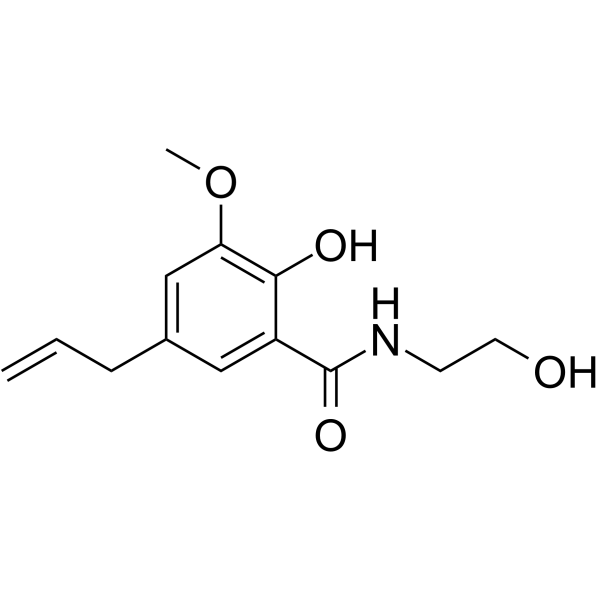
-
- HY-U00195
-
-

-
- HY-W201842
-
-

-
- HY-B0549AS
-
|
|
mAChR
|
Neurological Disease
|
|
Flavoxate-d4 (hydrochloride) (Rec-7-0040-d4) is the deuterium labeled Flavoxate hydrochloride. Flavoxate Hydrochloride is a muscarinic AChR antagonist used in various urinary syndromes and as an antispasmodic[1][2].
|
-
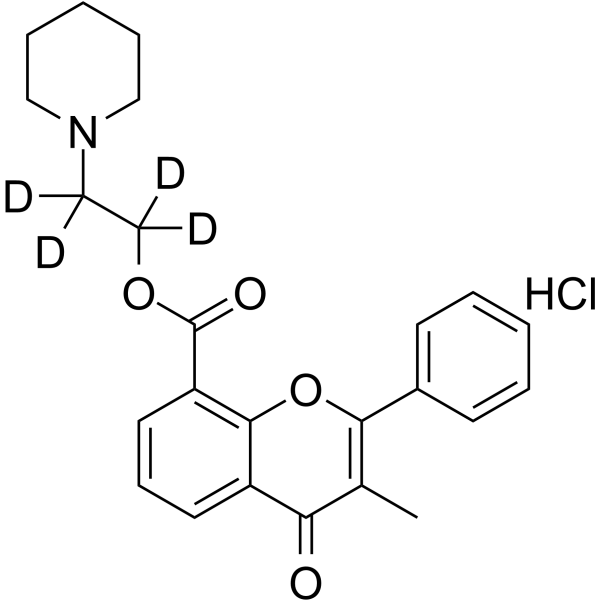
-
- HY-N4113
-
|
|
Keap1-Nrf2
AMPK
|
Cancer
|
|
Glycycoumarin is a potent antispasmodic agent. Glycycoumarin is a major bioactive coumarin of licorice and exhibits antispasmodic activity. Glycycoumarin also has hepatoprotective effect. Glycycoumarin can be used for the research of abdominal pain and liver diseases .
|
-
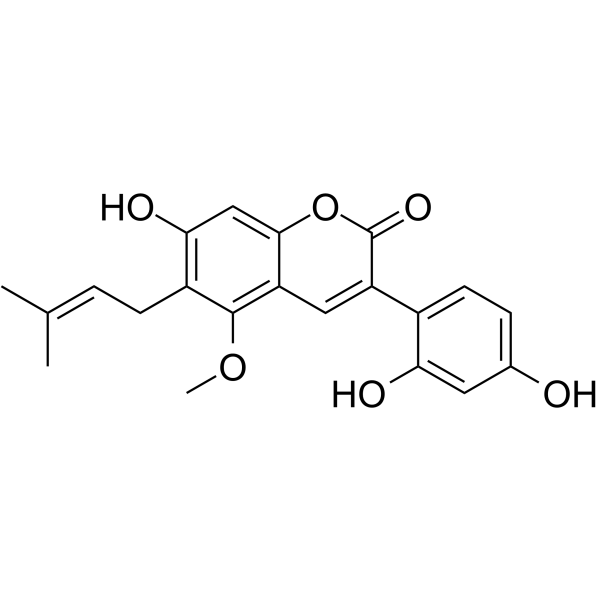
-
- HY-12770
-
-
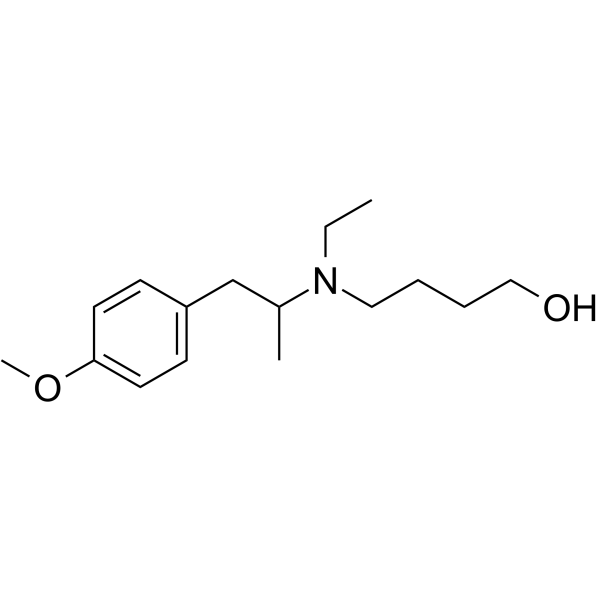
-
- HY-122086
-
-
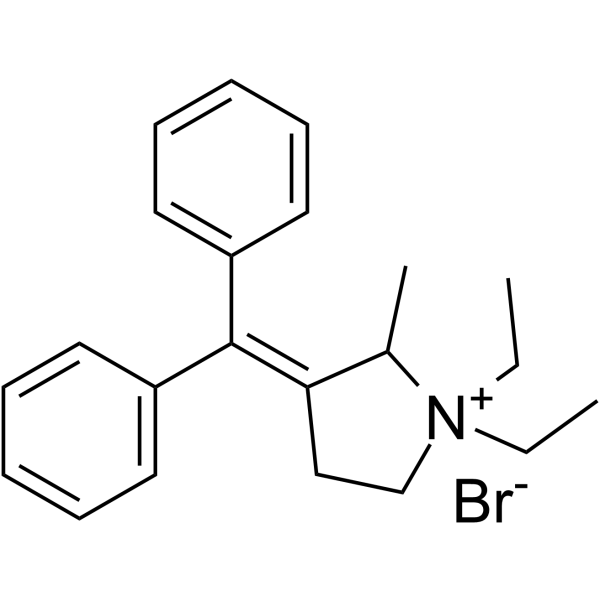
-
- HY-12771
-
|
Mebeverine metabolite O-desmethyl Mebeverine acid
|
Drug Metabolite
|
Neurological Disease
|
|
O-desmethyl Mebeverine acid is a metabolite of Mebeverine, which is a musculotropic antispasmodic drug.
|
-
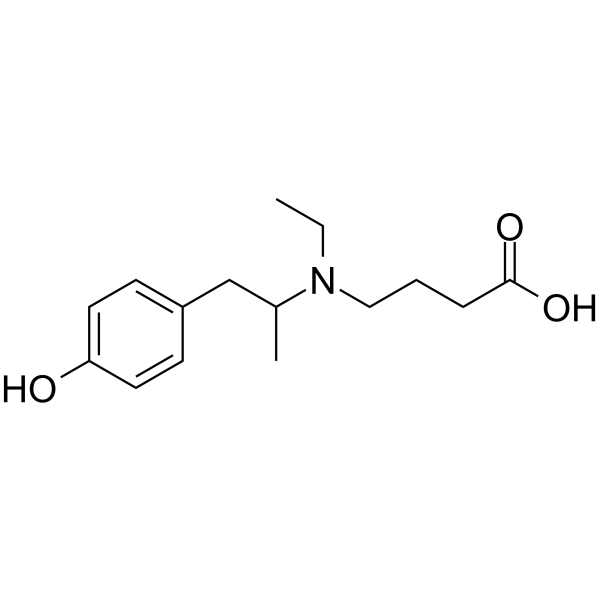
-
- HY-105652
-
-
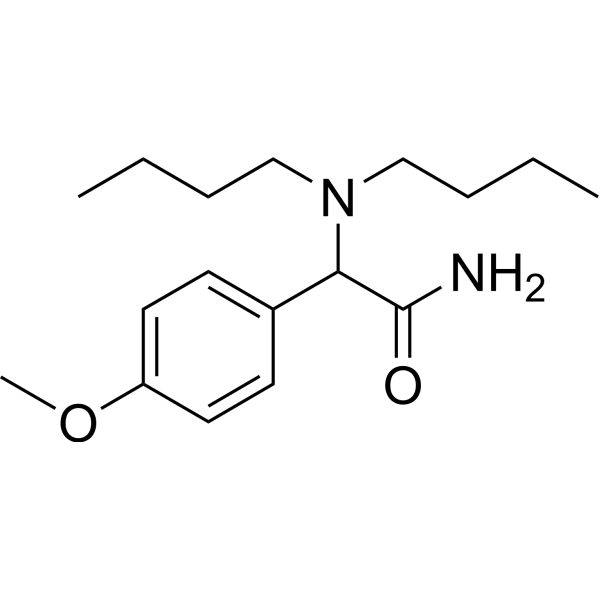
-
- HY-I0637
-
-
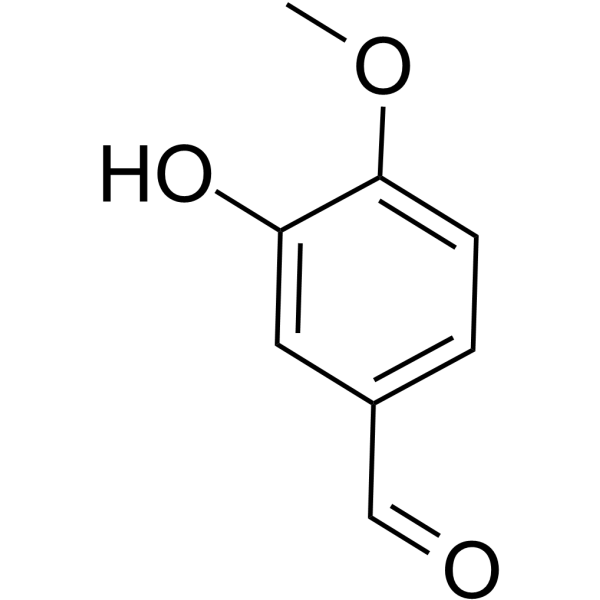
-
- HY-12769S
-
-
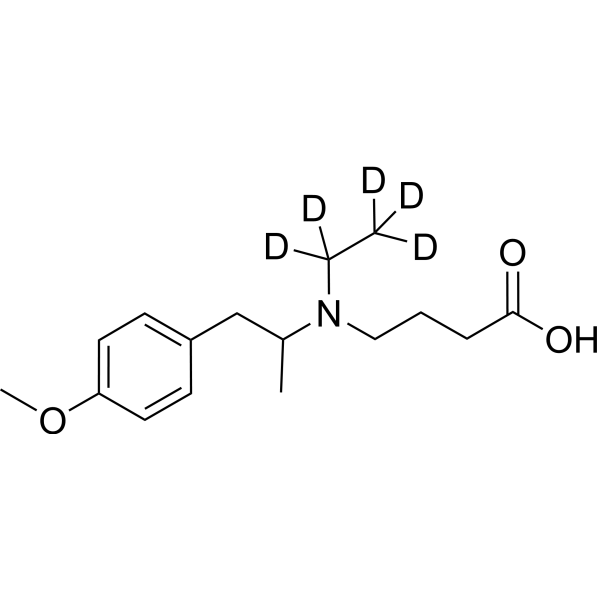
-
- HY-116755
-
|
CR 605
|
Others
|
Others
|
|
Tiropramide is an antispasmodic agent that plays important roles in spasmodic pain of the hepatobiliary and urinary tract .
|
-
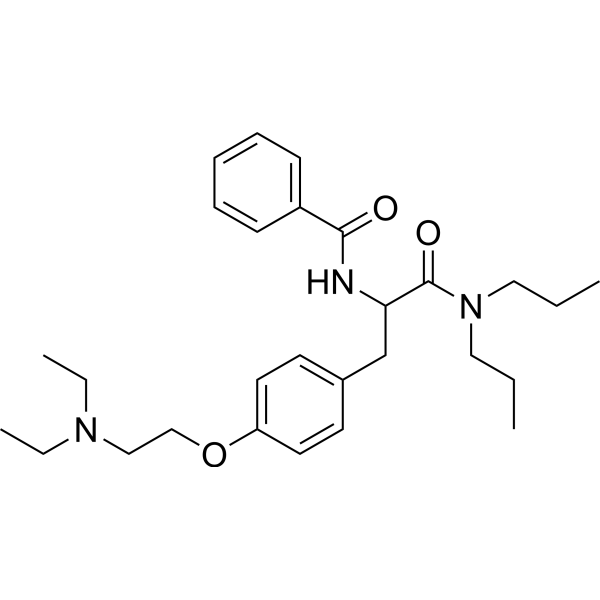
-
- HY-107349
-
-
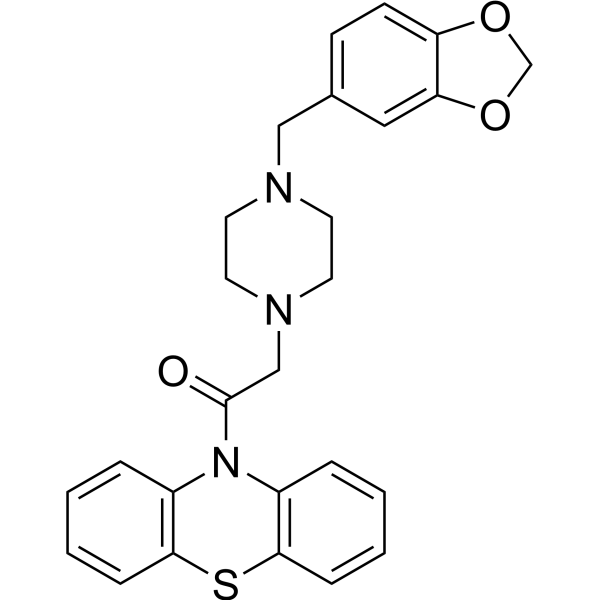
-
- HY-105771
-
|
|
mAChR
|
Neurological Disease
|
|
Parapenzolate bromide, an antispasmodic, is an orally active mAChR antagonist. Parapenzolate bromide is an anticholinergic agent .
|
-

-
- HY-N2842
-
|
|
Others
|
Inflammation/Immunology
|
|
α-Amyrin acetate, a natural triterpenoid, has anti-inflammatory activity, antispasmodic profile and the relaxant effect .
|
-
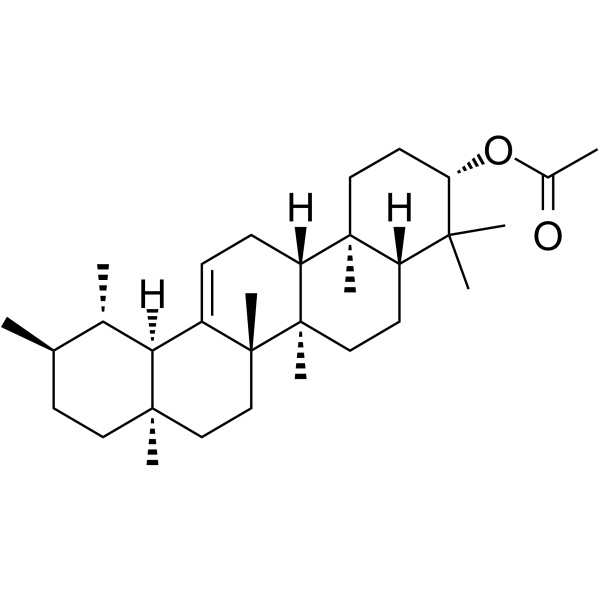
-
- HY-12769
-
|
Mebeverine metabolite Mebeverine acid
|
Drug Metabolite
|
Neurological Disease
|
|
Mebeverine acid (Mebeverine metabolite Mebeverine acid) is a secondary metabolite of Mebeverine. Mebeverine is an antispasmodic agent. Mebeverine acid is a valuable marker of oral exposure to Mebeverine .
|
-
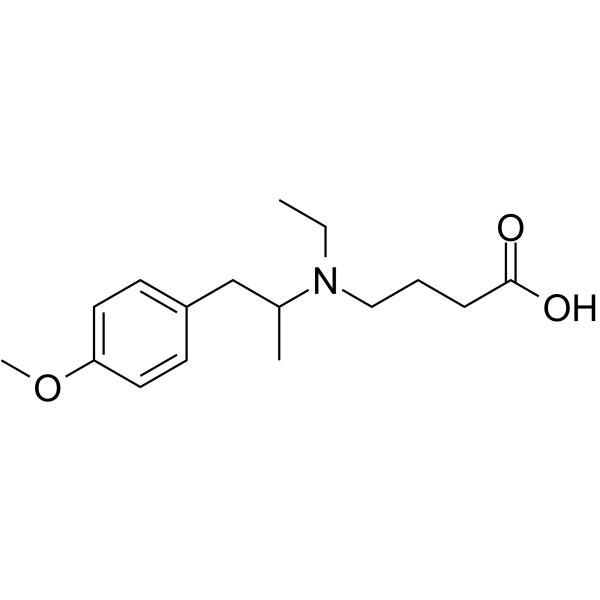
-
- HY-122520
-
|
|
Others
|
Neurological Disease
|
|
Fentonium bromide is an anti-ulcerogenic, anticholinergic and antispasmodic agent. Fentonium bromide can be used in the research of neurological conditions .
|
-
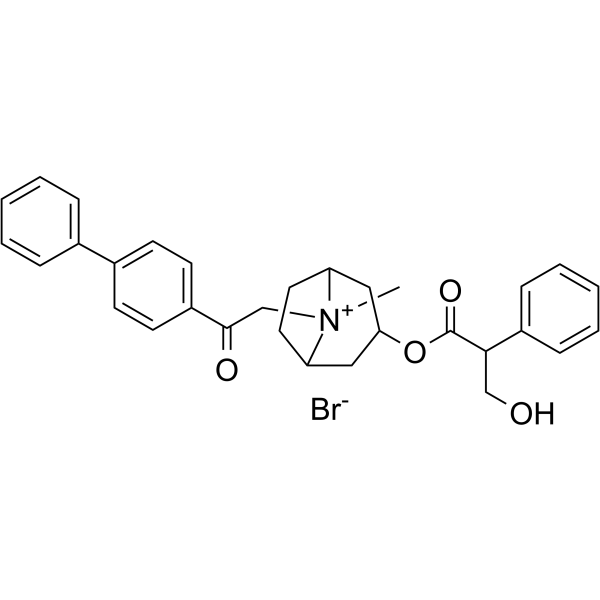
-
- HY-118524A
-
|
LD-935
|
Others
|
Neurological Disease
|
|
Dipiproverine (hydrochloride) is the hydrochloride form of Dipiproverine (HY-118524). Dipiproverine (hydrochloride) is an alpha-amino acid ester, an antispasmodic compound, which is used as an anticholinergic agent .
|
-
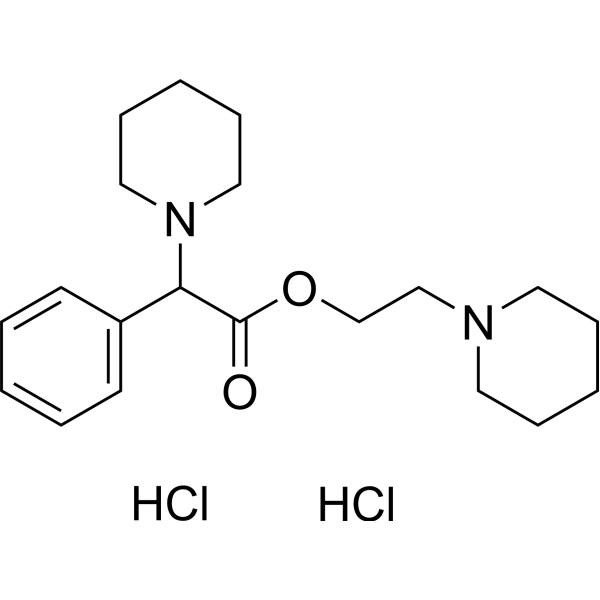
-
- HY-100562
-
|
|
5-HT Receptor
COMT
|
Neurological Disease
|
|
Flopropione is a 5-HT receptor antagonist and also a catechol-o-methyltransferase (COMT) inhibitor . Flopropione also as an antispasmodic agent .
|
-

-
- HY-111025
-
|
|
Others
|
Neurological Disease
|
Ectylurea,a N-acylurea,can be used in studies of tension and anxiety symptoms, has no effect on the autonomic nervous system, and has no convulsive, analgesic or antispasmodic activity in animals .
|
-
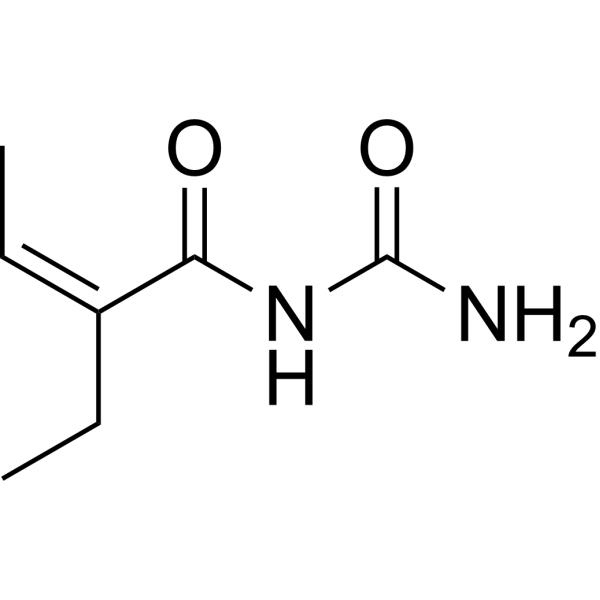
-
- HY-I0637S
-
|
3-Hydroxy-4-methoxybenzaldehyde-d3
|
Isotope-Labeled Compounds
|
|
|
Isovanillin-d3 is the deuterium labeled Isovanillin[1]. Isovanillin is an aldehyde oxidase inhibitor[2]. Antispasmodic activities[3]. Antidiarrheal activities[4].
|
-

-
- HY-121020
-
|
|
Phosphatase
|
Neurological Disease
|
|
Arcapillin is a flavonoid that can be isolated from Artemisia capillaris Thunb. Arcapillin has antispasmodic activity. Arcapillin also has moderate PTP1B inhibitory activity .
|
-
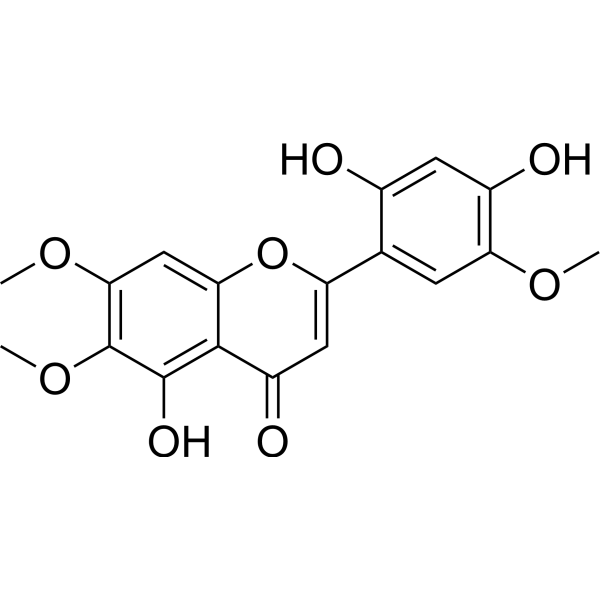
-
- HY-107349S
-
|
Spasmopriv-d8
|
Calcium Channel
|
Neurological Disease
|
|
Fenoverine-d8 is the deuterium labeled Fenoverine[1]. Fenoverine (Spasmopriv) is an antispasmodic agent and inhibits calcium channel currents[2]. Fenoverine induces rhabdomyolysis[3].
|
-
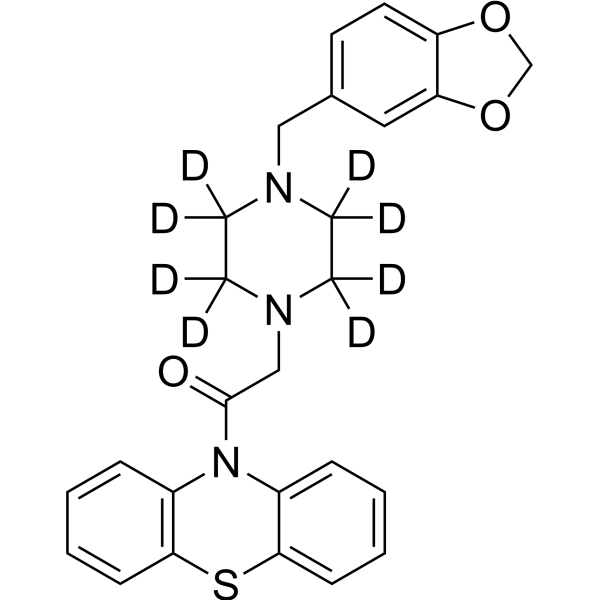
-
- HY-N2746
-
|
7-Geranyloxy-6-methoxycoumarin
|
Others
|
Neurological Disease
Metabolic Disease
|
|
7-O-Geranylscopoletin is a coumarin from the root of Atalantia monophylla. Various parts of this plant have been used for folk medicine for several purposes such as chronic rheumatism, paralysis, antispasmodic, stimulant and hemiplegia .
|
-
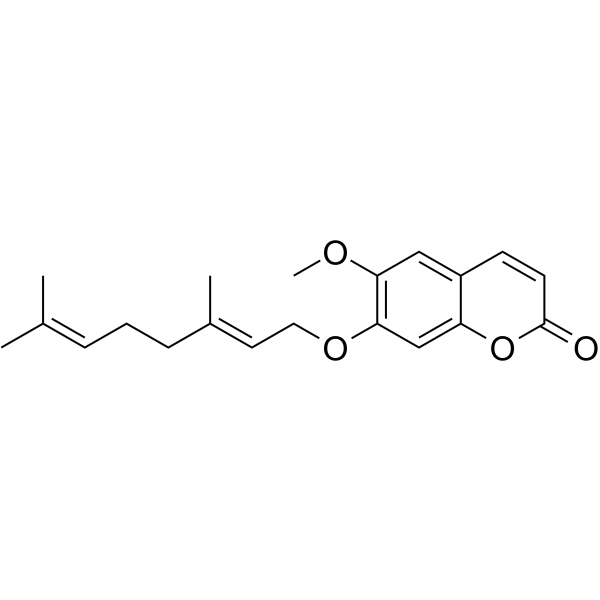
-
- HY-N2050
-
|
Desmethylbellidifolin
|
|
|
|
1,3,5,8-Tetrahydroxyxanthone (Desmethylbellidifolin) is a natural xanthone extracted from Swertia chirata. 1,3,5,8-Tetrahydroxyxanthone has antispasmodic effect and anti-inflammatory activity .
|
-
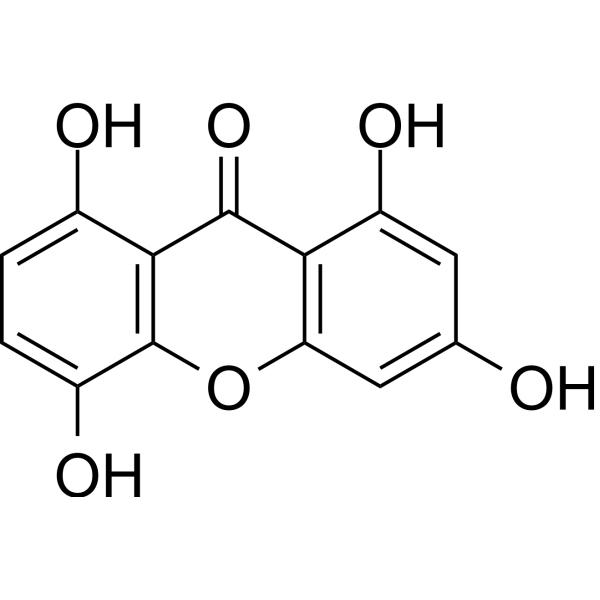
-
- HY-113123
-
-
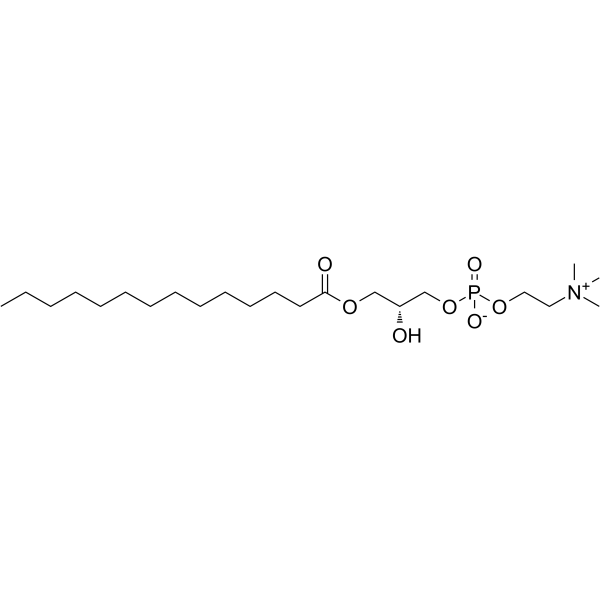
-
- HY-B1394
-
|
|
|
|
|
Khellin is a furochromone that can be isolated from Ammi visnuga L.. Khellin is an EGFR inhibitor with an IC50 of 0.15 µM. Khelline has anti-proliferative activity in vitro. Khellin has antispasmodic and coronary vasodilator effects .
|
-
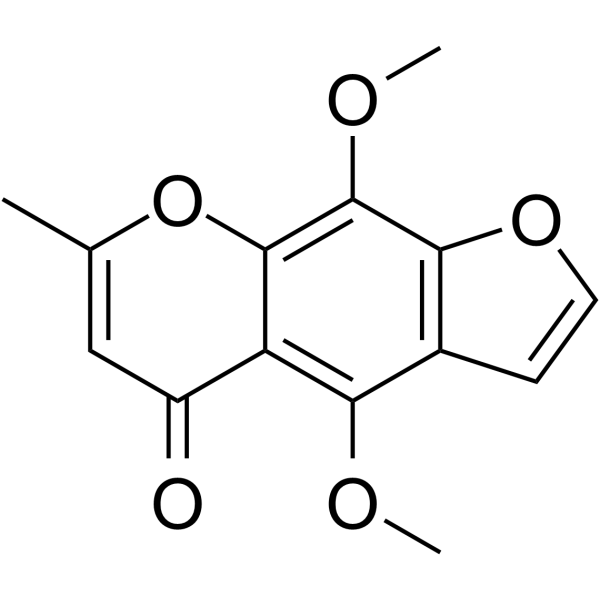
-
- HY-119918
-
|
|
mAChR
|
Neurological Disease
|
|
Cycrimine is an orally active muscarinic cholinergic receptor (mAChR) M1 antagonist, reduces the acetylcholine levels in parkinson model. Cycrimine shows antispasmodic activity, can be used in studies of behavioral and mental disorder .
|
-
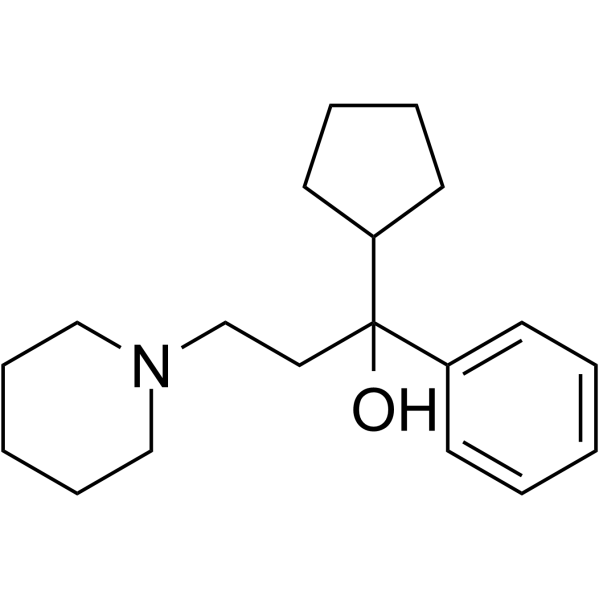
-
- HY-108964
-
|
|
Bacterial
|
Infection
Neurological Disease
Inflammation/Immunology
|
|
Carvone is a ketone monoterpene found mostly in the essential oils from plants of the genus Mentha. Carvone is widely used in the pharmaceutical industry, cosmetics and agriculture. Carvone has such effects as antimicrobial, antioxidant, anti-inflammatory, antispasmodic, antinociceptive, anticonvulsant .
|
-
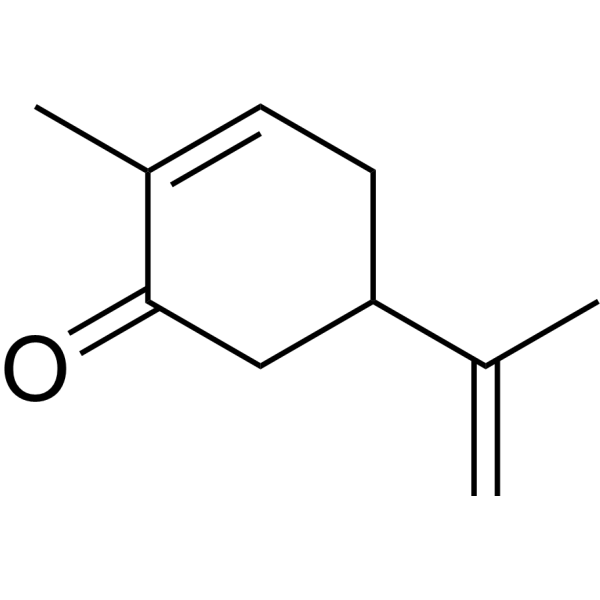
-
- HY-B2078A
-
|
|
|
|
|
Eprazinone dihydrochloride is a gent with mucolytic, secretolytic, antitussive, and bronchial antispasmodic properties. Eprazinone dihydrochloride is a neurokinin 1 receptor (NK1R) ligand. Eprazinone dihydrochloride has the potential for chronic bronchitis treatment that improved pulmonary function and arterial partial pressure of oxygen .
|
-
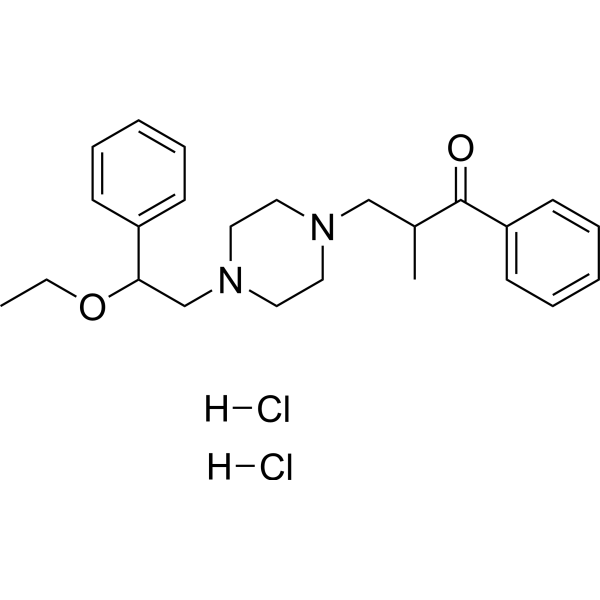
-
- HY-B1806A
-
|
Pathilon chloride
|
mAChR
|
Neurological Disease
Inflammation/Immunology
|
|
Tridihexethyl (Pathilon) chloride is an orally active anticholinergic agent and mAChR antagonist, shows activities of antimuscarinic and anticholinergic. Tridihexethyl chloride shows pronounced antispasmodic and antisecretory effects on the gastrointestinal tract. Tridihexethyl chloride can be used in studies of peptic ulcer disease and acquired nystagmus .
|
-
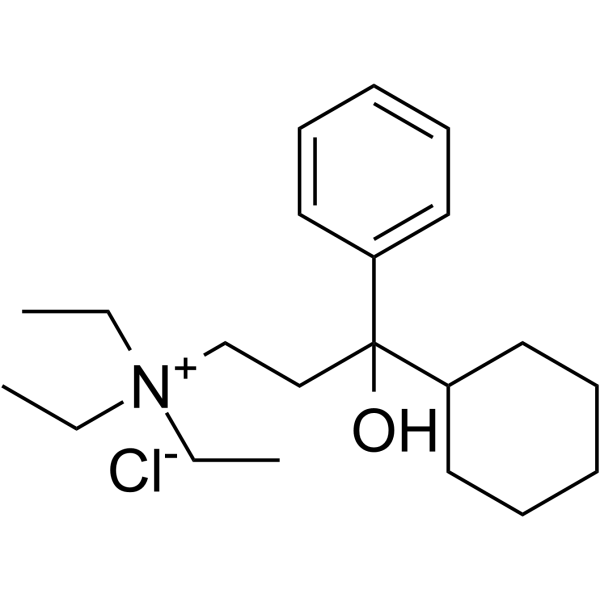
-
- HY-16489
-
|
|
Potassium Channel
mAChR
Calcium Channel
|
Metabolic Disease
|
|
Terodiline, an antispasmodic agent, blocks hERG current with the IC50 of 375 nM. Terodiline has both anticholinergic and calcium antagonist properties, and effectively reduces abnormal bladder contractions caused by detrusor instability. Terodiline can be used for the research of urinary incontinence .
|
-
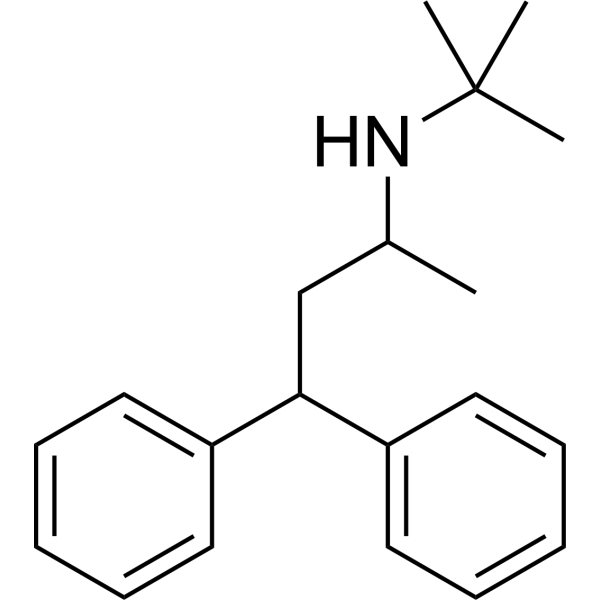
-
- HY-B0549A
-
|
Rec-7-0040; DW61
|
Phosphodiesterase (PDE)
Calcium Channel
mAChR
|
Neurological Disease
|
|
Flavoxate hydrochloride is a potent and competitive phosphodiesterase (PDE) inhibitor. Flavoxate hydrochloride is an antispasmodic agent and muscarinic mAChR antagonist. Flavoxate hydrochloride shows moderate calcium antagonistic activity and local anesthetic effect. Flavoxate hydrochloride can be used for the research of overactive bladder (OAB) and lower urinary tract infections .
|
-
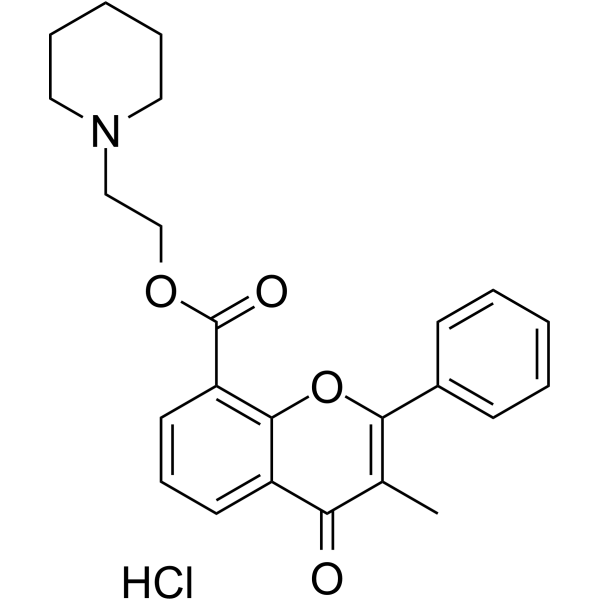
-
- HY-108974
-
|
|
Phosphodiesterase (PDE)
Calcium Channel
|
|
|
Drotaverine (hydrochloride) is a type 4 cyclic nucleotide phosphodiesterase (PDE4) inhibitor and an L-type voltage-dependent calcium channel (L-VDCC) blocker, blocks the degradation of 3',5'-cyclic adenosine monophosphate. Drotaverine (hydrochloride) exhibits in vivo antispasmodic efficacy without anticholinergic effects.
|
-
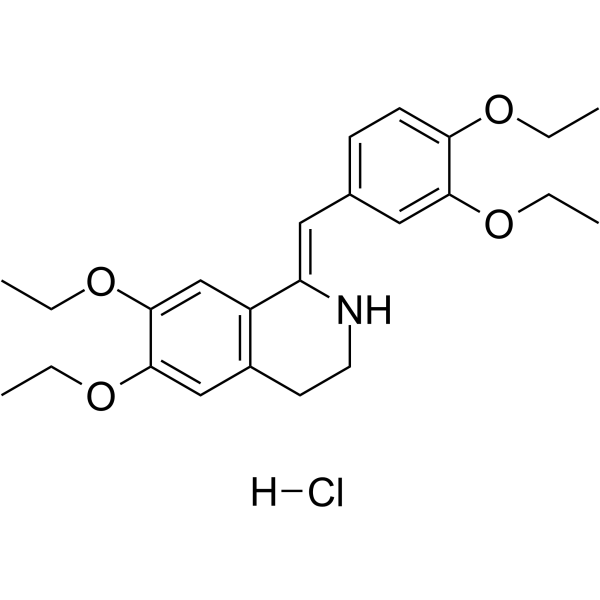
-
- HY-B0549
-
|
Rec-7-0040 free base; DW61 free base
|
Phosphodiesterase (PDE)
Calcium Channel
mAChR
|
Neurological Disease
|
|
Flavoxate is a potent and competitive phosphodiesterase (PDE) inhibitor. Flavoxate is an antispasmodic agent and muscarinic mAChR antagonist. Flavoxate shows moderate calcium antagonistic activity and local anesthetic effect. Flavoxate can be used for the research of overactive bladder (OAB) and lower urinary tract infections .
|
-
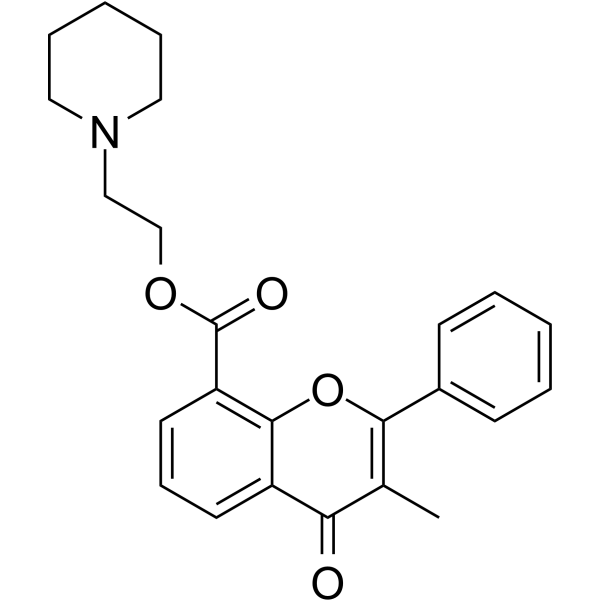
-
- HY-12752
-
|
Trimeprazine
|
Histamine Receptor
|
Neurological Disease
Inflammation/Immunology
|
|
Alimemazine is a phenothiazine derivative that is generally used as an antipruritic agent and also a hemagglutinin (HA)-receptor antagonist.Alimemazine (Trimeprazine) is also acts as a partial agonist against the histamine H1 receptor (H1R) and other GPCRs. Alimemazine displays antiserotonin, antispasmodic, and antiemetic properties .
|
-
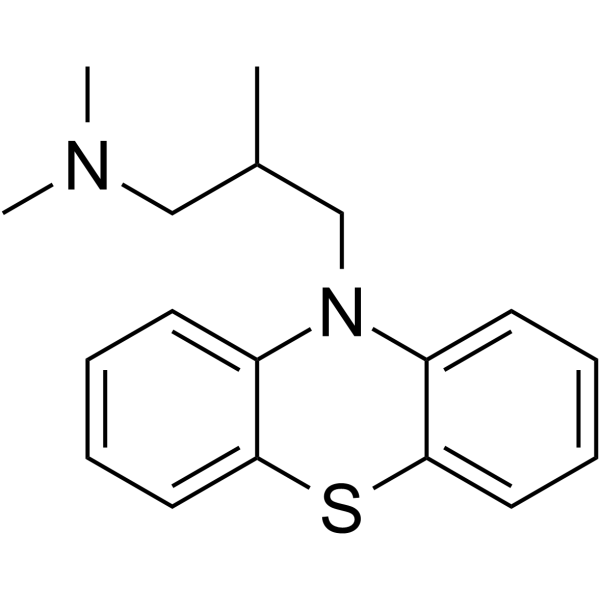
-
- HY-B0267C
-
|
Aroxybutynin
|
mAChR
|
Neurological Disease
|
|
(R)-Oxybutynin (Aroxybutynin) is the racemic isomer of Oxybutynin and an orally active muscarinic receptor antagonist. (R)-Oxybutynin has antispasmodic, antimuscarinic, and anticholinergic activities and competitively antagonizes carbachol-induced contractions. (R)-Oxybutynin can be used to study urinary incontinence caused by neurogenic bladder dysfunction .
|
-

-
- HY-14621
-
|
Vanillylacetone; Gingerone
|
NF-κB
|
Metabolic Disease
Inflammation/Immunology
Cancer
|
|
Zingerone (Vanillylacetone) is a nontoxic methoxyphenol isolated from Zingiber officinale, with potent anti-inflammatory, antidiabetic, antilipolytic, antidiarrhoeic, antispasmodic and anti-tumor properties . Zingerone alleviates oxidative stress and inflammation, down-regulates NF-κB mediated signaling pathways . Zingerone acts as an anti-mitotic agent, and inhibits the growth of neuroblastoma cells .
|
-
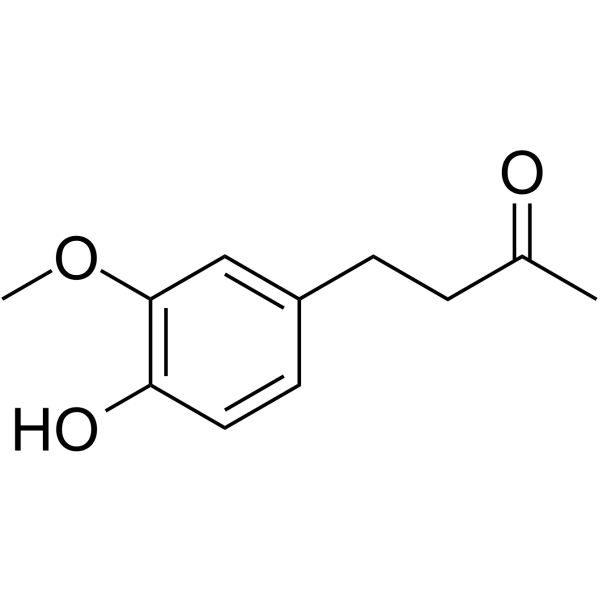
-
- HY-108974S
-
|
|
Isotope-Labeled Compounds
Phosphodiesterase (PDE)
Calcium Channel
|
|
|
Drotaverine-d10 (hydrochloride) is the deuterium labeled Drotaverine hydrochloride. Drotaverine hydrochloride is a type 4 cyclic nucleotide phosphodiesterase (PDE4) inhibitor and an L-type voltage-dependent calcium channel (L-VDCC) blocker, blocks the degradation of 3',5'-cyclic adenosine monophosphate. Drotaverine hydrochloride exhibits in vivo antispasmodic efficacy without anticholinergic effects[1][2].
|
-
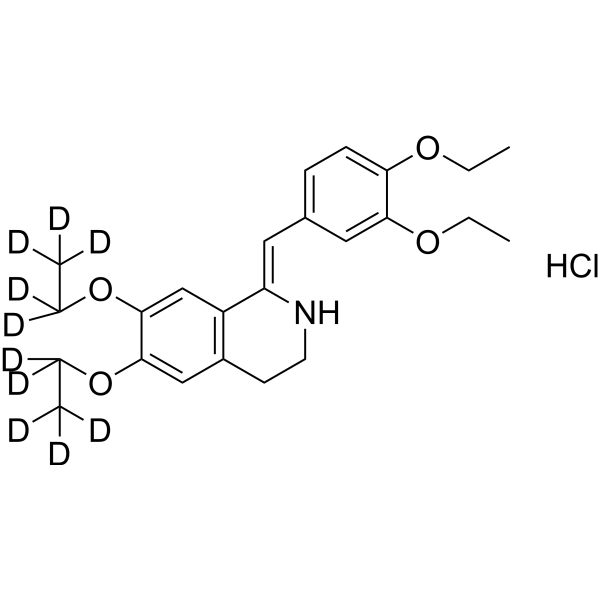
-
- HY-B1339
-
|
Dicycloverine hydrochloride
|
mAChR
|
Neurological Disease
|
|
Dicyclomine hydrochloride is a potent and orally active muscarinic cholinergic receptors antagonist. Dicyclomine hydrochloride shows high affinity for muscarinic M1 receptor subtype (Ki=5.1 nM) and M2 receptor subtype (Ki=54.6 nM) in brush-border membrane and basal plasma membranes, respectively . Dicyclomine is an antispasmodic agent and relieves smooth muscle spasm of the gastrointestinal tract in vivo .
|
-
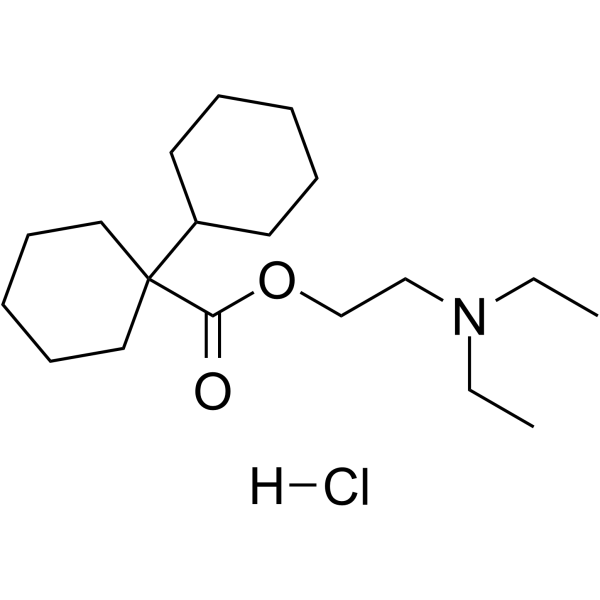
-
- HY-B1339A
-
|
Dicycloverine
|
mAChR
|
|
|
Dicyclomine (Dicycloverine) is a potent and orally active muscarinic cholinergic receptors antagonist. Dicyclomine (Dicycloverine) shows high affinity for muscarinic M1 receptor subtype (Ki=5.1 nM) and M2 receptor subtype (Ki=54.6 nM) in brush-border membrane and basal plasma membranes, respectively . Dicyclomine is an antispasmodic agent and relieves smooth muscle spasm of the gastrointestinal tract in vivo .
|
-
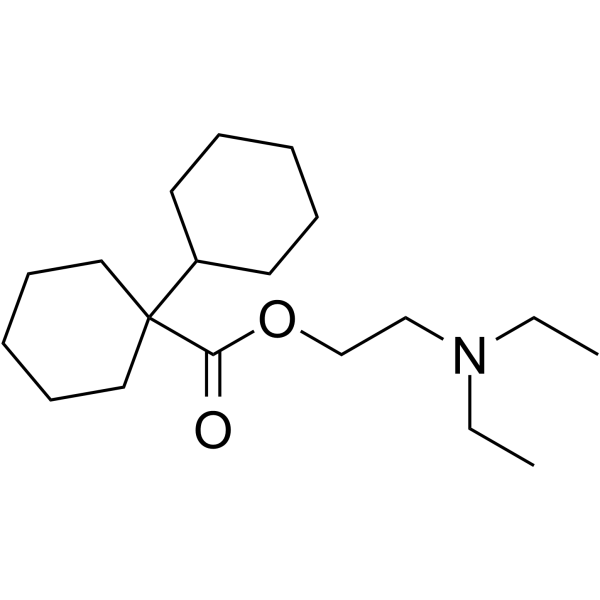
-
- HY-N11706
-
|
(+)-β-Cedrene
|
Fungal
|
Infection
Inflammation/Immunology
|
|
β-Cedrene ((+)-β-Cedrene) is a sesquiterpene compound that can be isolated from Centaurea kotschyi var. kotschyi and Centaurea kotschyi var. decumbens, exhibiting antibacterial, anti-inflammatory, antispasmodic, tonic, diuretic, sedative, insecticidal, and antifungal activities. β-Cedrene is also a potent competitive inhibitor of the CYP2B6-mediatedbupropion hydroxylase, with a Ki value of 1.6 μM .
|
-
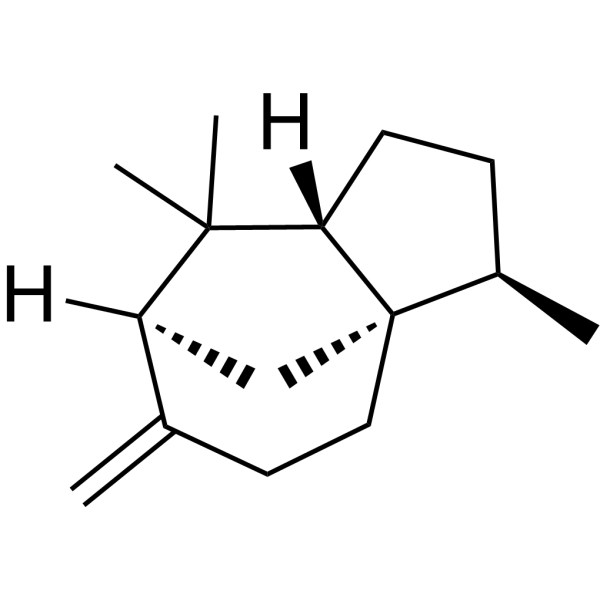
-
- HY-B0267B
-
|
Aroxybutynin hydrochloride
|
mAChR
|
Neurological Disease
|
|
(R)-Oxybutynin hydrochloride, a (R)-isomer of Oxybutynin hydrochloride, is an orally active muscarinic receptor antagonist. (R)-Oxybutynin hydrochloride has antimuscarinic, antispasmodic and anticholinergic activity, competitively antagonizes Carbachol-induced contractions. (R)-Oxybutynin hydrochloride can be used for researching incontinence due to neurogenic bladder dysfunction . (R)-Oxybutynin (hydrochloride) is a click chemistry reagent, it contains an Alkyne group and can undergo copper-catalyzed azide-alkyne cycloaddition (CuAAc) with molecules containing Azide groups.
|
-

-
- HY-B1339AS
-
|
Dicycloverine-d4
|
mAChR
|
|
|
Dicyclomine-d4 is the deuterium labeled Dicyclomine[1]. Dicyclomine (Dicycloverine) is a potent and orally active muscarinic cholinergic receptors antagonist. Dicyclomine (Dicycloverine) shows high affinity for muscarinic M1 receptor subtype (Ki=5.1 nM) and M2 receptor subtype (Ki=54.6 nM) in brush-border membrane and basal plasma membranes, respectively[2]. Dicyclomine is an antispasmodic agent and relieves smooth muscle spasm of the gastrointestinal tract in vivo[3].
|
-

- HY-157959
-
|
(±)-Orphenadrine
|
iGluR
Cytochrome P450
Cholinesterase (ChE)
|
Neurological Disease
Cancer
|
|
Orphenadrine ((±)-Orphenadrine) is a skeletal muscle relaxant and NMDA antagonist that also has antiparkinsonian, antihistamine, antitremor, antispasmodic, and analgesic effects. Orphenadrine inhibits the binding of [3H]MK-801 to the phencyclidine (PCP) binding site of the NMDA receptor. Orphenadrine is also an anticholinergic and cytochrome P450 (CYP) 2B inducer. Orphenadrine may exert pro-tumor effects, causing CAR nuclear translocation, resulting in microsomal reactive oxygen species (ROS) production and oxidative stress. Orphenadrine also exerts neuronal protection, protecting rat cerebellar granule cells (CGC) from 3-NPA-induced death and has inhibitory potential against neurodegenerative diseases mediated by NMDA receptor overactivation .
|
-
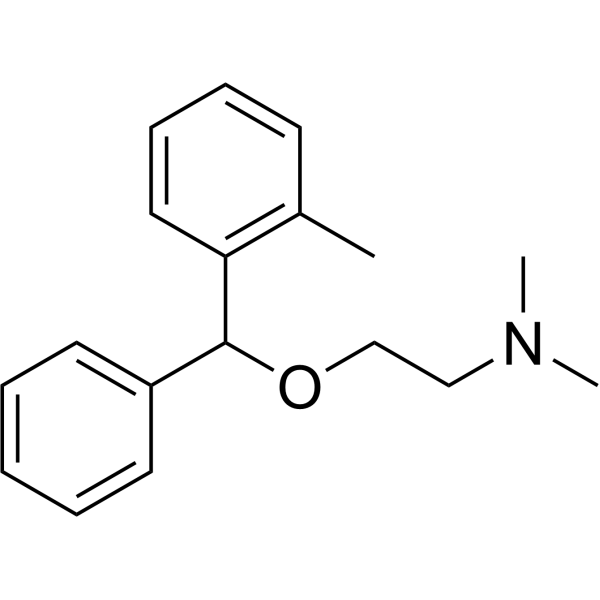
| Cat. No. |
Product Name |
Category |
Target |
Chemical Structure |
-
- HY-N2604
-
-

-
- HY-N0820
-
-

-
- HY-N5086
-
-

-
- HY-13557
-
-

-
- HY-N2071
-
Cedrol
1 Publications Verification
(+)-Cedrol; α-Cedrol
|
Cedrus deodara (Roxburgh) G. Don
Classification of Application Fields
Pinaceae
Terpenoids
Sesquiterpenes
Source classification
Plants
Inflammation/Immunology
Disease Research Fields
Cancer
|
Cytochrome P450
Fungal
|
|
Cedrol is a bioactive sesquiterpene, a potent competitive inhibitor of cytochrome P-450 (CYP) enzymes. Cedrol inhibits CYP2B6-mediated bupropion hydroxylase and CYP3A4-mediated midazolam hydroxylation with Ki of 0.9 μM and 3.4 μM, respectively. Cedrol also has weak inhibitory effect on CYP2C8, CYP2C9, and CYP2C19 enzymes . Cedrol is found in cedar essential oil and poetesses anti-septic, anti-inflammatory, anti-spasmodic, tonic, astringent, diuretic, insecticidal, and anti-fungal activities .
|
-

-
- HY-N4113
-
-

-
- HY-I0637
-
-

-
- HY-N2842
-
-

-
- HY-100562
-
-

-
- HY-121020
-
-

-
- HY-N2746
-
-

-
- HY-113123
-
-

-
- HY-108964
-
-

-
- HY-14621
-
-

-
- HY-N11706
-
-

| Cat. No. |
Product Name |
Chemical Structure |
-
- HY-107349S
-
|
|
|
Fenoverine-d8 is the deuterium labeled Fenoverine[1]. Fenoverine (Spasmopriv) is an antispasmodic agent and inhibits calcium channel currents[2]. Fenoverine induces rhabdomyolysis[3].
|
-

-
- HY-133153S
-
|
|
|
Fenpiverinium-d3 (bromide) is a deuterium labeled Fenpiverinium bromide. Fenpiverinium bromide has anti-cholinergic and anti-spasmodic effects[1].
|
-

-
- HY-B0549AS
-
|
|
|
Flavoxate-d4 (hydrochloride) (Rec-7-0040-d4) is the deuterium labeled Flavoxate hydrochloride. Flavoxate Hydrochloride is a muscarinic AChR antagonist used in various urinary syndromes and as an antispasmodic[1][2].
|
-

-
- HY-12769S
-
|
|
|
Mebeverine acid-d5 is the deuterium labeled Mebeverine Acid; Mebeverine Acid is a metabolite of Mebeverine, that is an antispasmodic.
|
-

-
- HY-I0637S
-
|
|
|
Isovanillin-d3 is the deuterium labeled Isovanillin[1]. Isovanillin is an aldehyde oxidase inhibitor[2]. Antispasmodic activities[3]. Antidiarrheal activities[4].
|
-

-
- HY-108974S
-
|
|
|
Drotaverine-d10 (hydrochloride) is the deuterium labeled Drotaverine hydrochloride. Drotaverine hydrochloride is a type 4 cyclic nucleotide phosphodiesterase (PDE4) inhibitor and an L-type voltage-dependent calcium channel (L-VDCC) blocker, blocks the degradation of 3',5'-cyclic adenosine monophosphate. Drotaverine hydrochloride exhibits in vivo antispasmodic efficacy without anticholinergic effects[1][2].
|
-

-
- HY-B1339AS
-
|
|
|
Dicyclomine-d4 is the deuterium labeled Dicyclomine[1]. Dicyclomine (Dicycloverine) is a potent and orally active muscarinic cholinergic receptors antagonist. Dicyclomine (Dicycloverine) shows high affinity for muscarinic M1 receptor subtype (Ki=5.1 nM) and M2 receptor subtype (Ki=54.6 nM) in brush-border membrane and basal plasma membranes, respectively[2]. Dicyclomine is an antispasmodic agent and relieves smooth muscle spasm of the gastrointestinal tract in vivo[3].
|
-

Your information is safe with us. * Required Fields.
Inquiry Information
- Product Name:
- Cat. No.:
- Quantity:
- MCE Japan Authorized Agent:



























































